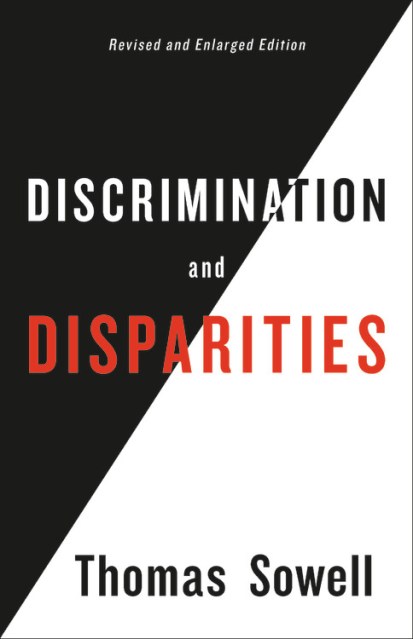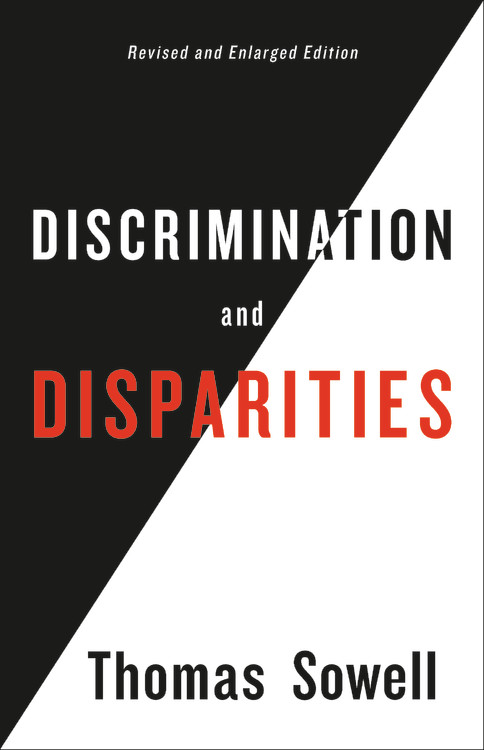Promotion
Use code BEST25 for 25% off storewide. Make sure to order by 11:59am, 12/12 for holiday delivery!
By clicking “Accept,” you agree to the use of cookies and similar technologies on your device as set forth in our Cookie Policy and our Privacy Policy. Please note that certain cookies are essential for this website to function properly and do not require user consent to be deployed.
Discrimination and Disparities
Contributors
Formats and Prices
- On Sale
- Mar 5, 2019
- Page Count
- 320 pages
- Publisher
- Basic Books
- ISBN-13
- 9781541645639
Price
$30.00Price
$38.00 CADFormat
Format:
- Hardcover (Enlarged) $30.00 $38.00 CAD
- ebook (Enlarged) $18.99 $24.99 CAD
- Audiobook Download (Unabridged) $27.99
This item is a preorder. Your payment method will be charged immediately, and the product is expected to ship on or around March 5, 2019. This date is subject to change due to shipping delays beyond our control.
Buy from Other Retailers:
An enlarged edition of Thomas Sowell’s brilliant examination of the origins of economic disparities
Economic and other outcomes differ vastly among individuals, groups, and nations. Many explanations have been offered for the differences. Some believe that those with less fortunate outcomes are victims of genetics. Others believe that those who are less fortunate are victims of the more fortunate.
Discrimination and Disparities gathers a wide array of empirical evidence to challenge the idea that different economic outcomes can be explained by any one factor, be it discrimination, exploitation, or genetics. This revised and enlarged edition also analyzes the human consequences of the prevailing social vision of these disparities and the policies based on that vision–from educational disasters to widespread crime and violence.
-
"Sowell's calm and calculated look at racial disparity in America is a stunning work of brevity and reason."Federalist
-
"Timely...a must-read."Rush Limbaugh, The Limbaugh Letter
-
"A sane, balanced and highly informed discussion of many of the central issues of the day."Washington Times
-
"Everything Dr. Sowell writes is worth reading, but this book couldn't be more timely. If there is any topic that needs a strong dose of empirical data and common sense, it is this one."Power Line
-
"[Sowell] writes on economics in a manner that is not only accessible, but also relevant and even riveting."The Conservative Woman
-
"Few works on politically explosive topics maintain such a consistent focus on empirical evidence while avoiding rhetorical jabs at opponents...those who cling to this dogma with religious fervor will likely avoid Sowell's fact-filled book like kryptonite. Folks with less dogmatic proclivities, however, would do well to peruse this concise work."American Thinker
-
"Throughout his career, Thomas Sowell has been fearless in confronting uncomfortable facts about human nature and ill-conceived public policies. His new book, Discrimination and Disparities, is the latest in a long line of works that calmly but persuasively shatter myths and ideological beliefs about race, ethnicity, economics, history, and culture."New York Journal of Books
-
“Thomas Sowell’s Discrimination and Disparities is must reading for anyone who wants to understand what drives economic and social inequality among different groups. Sowell has spent a career bringing clarity and insight to heated public policy discussions that too often lack both. And no topic today is more in need of the Sowell treatment than the one surrounding racial and ethnic disparities. You don’t need a Ph.D. to understand this book, and having read it you will be far better informed than most of the academic and media elites sounding off on the subject.”Jason Riley, author of Please Stop Helping Us and False Black Power?
-
“In this provocative book, Thomas Sowell turns the tables on those who automatically link disparate outcomes to discrimination. He begins by focusing instead on the myriad of factors that need to come together for success. Before we can explain why people fall behind in life, we must first understand what life demands for success…. Native intelligence by itself does not guarantee success. Hard work is important, but nature can be capricious. Who knew that being first born is a persistent factor for success in life? The book is chock full of such pertinent observations, none of which reflect discrimination by anyone. The book is a wonderful short introduction to the thought of one of our most important social thinkers.”Gerald P. O’Driscoll, Jr., Senior Fellow, CATO Institute
Newsletter Signup
By clicking ‘Sign Up,’ I acknowledge that I have read and agree to Hachette Book Group’s Privacy Policy and Terms of Use







